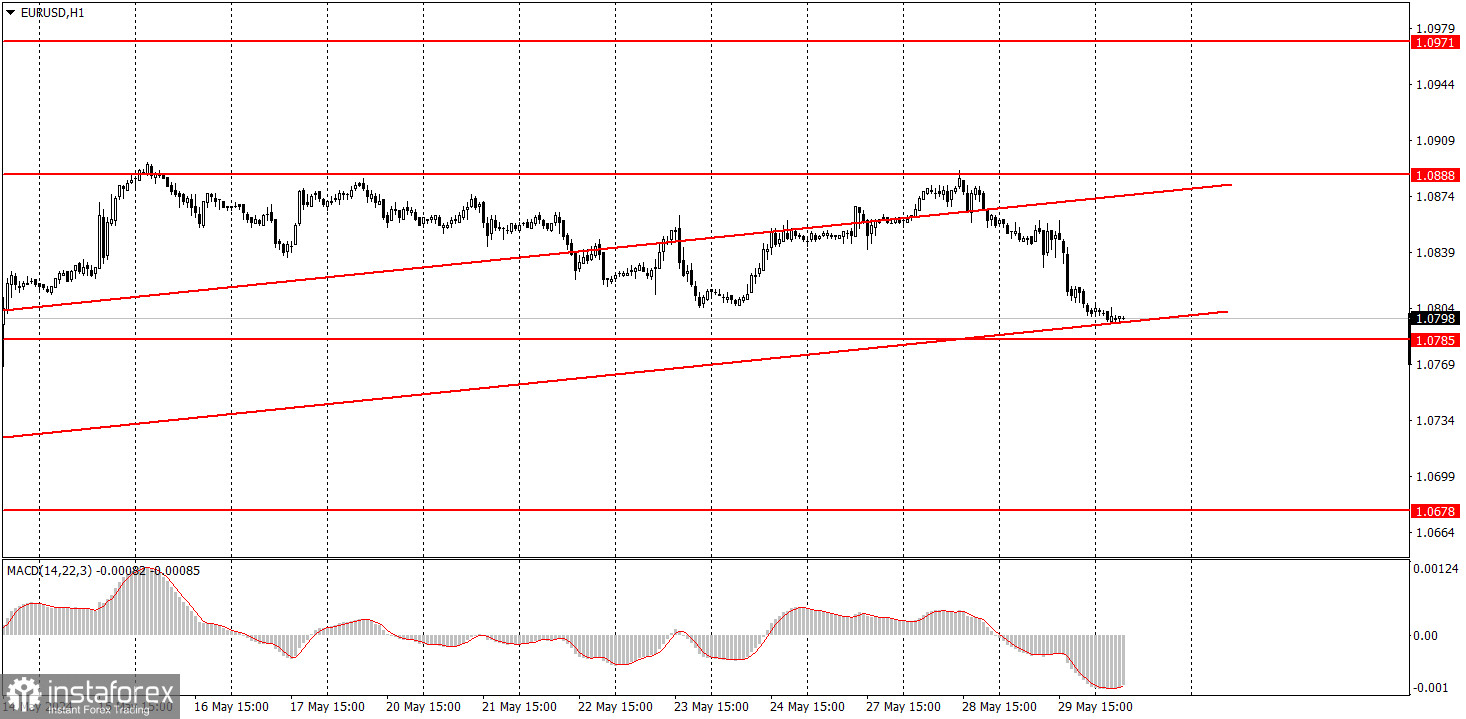Analyzing Wednesday's trades:
EUR/USD on 1H chart

EUR/USD continued to trade lower on Wednesday, which started after the second bounce from the level of 1.0888. Although a lot of people wish to see a downward trend, we must acknowledge the fact that EUR/USD is currently showing more of a flat phase than a trend. As seen in the chart above, the price has been between the levels of 1.0785 and 1.0888 for over two weeks. Furthermore, the ascending channel, which has been supporting the euro for the past month and a half, remains relevant. It has been extremely difficult to suspect that a downtrend is emerging, even if everyone is waiting for it. However, if the price consolidates below the ascending channel and the level of 1.0785, this can increase the likelihood of a prolonged and significant decline in the euro, which has been rising in recent weeks on pure enthusiasm and the market's unrestrained desire to buy it for no apparent reason.
EUR/USD on 5M chart

Six trading signals were generated on the 5-minute timeframe. These signals were formed around the levels of 1.0838 and 1.0856, with a distance of only 18 pips between them. Therefore, it made no sense to open trades on rebounds from these levels. The most that traders could expect was to gain around 5 pips of profit. It only made sense to act when the price consolidated below the level of 1.0838, after which the price fell to the level of 1.0797. The profit amounted to approximately 25 pips.
Trading tips on Thursday:
On the hourly chart, the bullish correction remains intact, which is gradually turning into a flat. We believe that the euro should fall in the medium term, as the overall trend remains bearish. Nevertheless, the market still refuses to buy the dollar for unknown reasons and volatility also remains low. Traders should consider this information before they decide to open any trades.
On Thursday, novice traders may look for signals around the area of 1.0785-1.0797. You may consider sell signals, but the euro could also rise at any moment. Consolidation below the ascending channel may suggest the end of the euro's rise.
The key levels on the 5M chart are 1.0483, 1.0526, 1.0568, 1.0611, 1.0678, 1.0725-1.0733, 1.0785-1.0797, 1.0838-1.0856, 1.0888-1.0896, 1.0940, and 1.0971-1.0981. On Thursday, the Eurozone unemployment report will be published, which is not crucial. The US docket will feature reports on initial jobless claims and the GDP numbers for Q1. These reports are unlikely to provoke any market reaction.
Basic trading rules:
1) Signal strength is determined by the time taken for its formation (either a bounce or level breach). A shorter formation time indicates a stronger signal.
2) If two or more trades around a certain level are initiated based on false signals, subsequent signals from that level should be disregarded.
3) In a flat market, any currency pair can produce multiple false signals or none at all. In any case, the flat trend is not the best condition for trading.
4) Trading activities are confined between the onset of the European session and mid-way through the U.S. session, after which all open trades should be manually closed.
5) On the 30-minute timeframe, trades based on MACD signals are only advisable amidst substantial volatility and an established trend, confirmed either by a trendline or trend channel.
6) If two levels lie closely together (ranging from 5 to 15 pips apart), they should be considered as a support or resistance zone.
How to read charts:
Support and Resistance price levels can serve as targets when buying or selling. You can place Take Profit levels near them.
Red lines represent channels or trend lines, depicting the current market trend and indicating the preferable trading direction.
The MACD(14,22,3) indicator, encompassing both the histogram and signal line, acts as an auxiliary tool and can also be used as a signal source.
Significant speeches and reports (always noted in the news calendar) can profoundly influence the price dynamics. Hence, trading during their release calls for heightened caution. It may be reasonable to exit the market to prevent abrupt price reversals against the prevailing trend.
Beginning traders should always remember that not every trade will yield profit. Establishing a clear strategy coupled with sound money management is the cornerstone of sustained trading success.





















